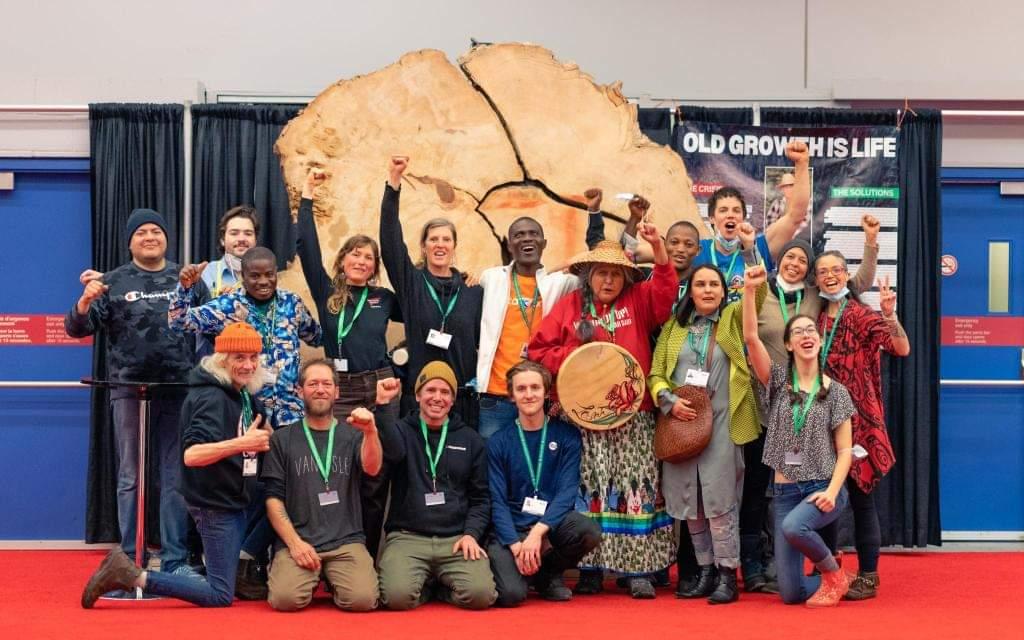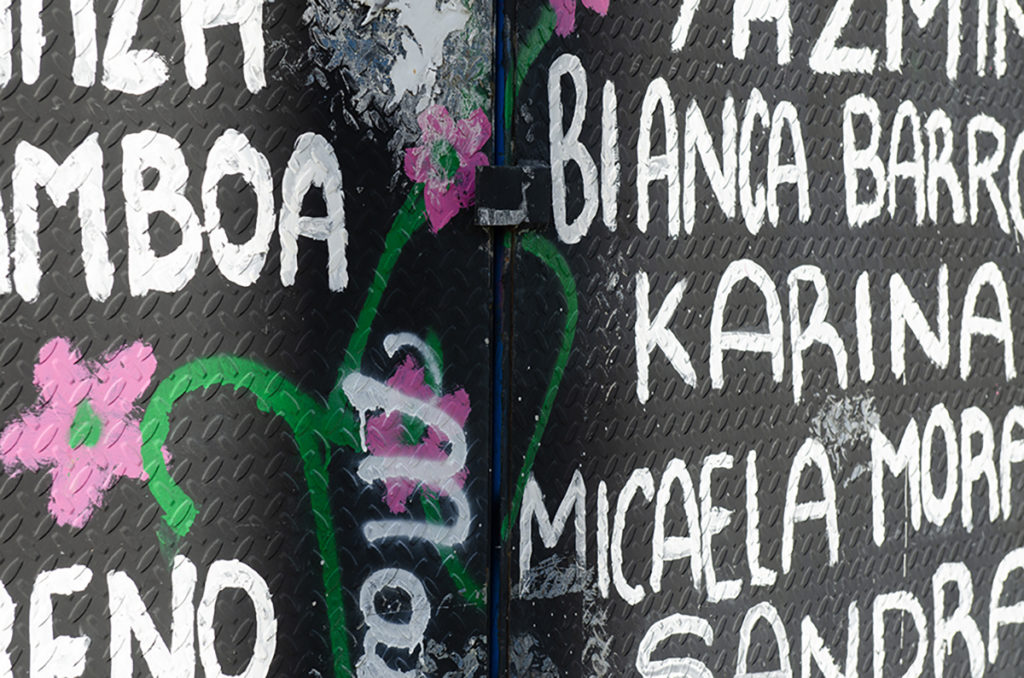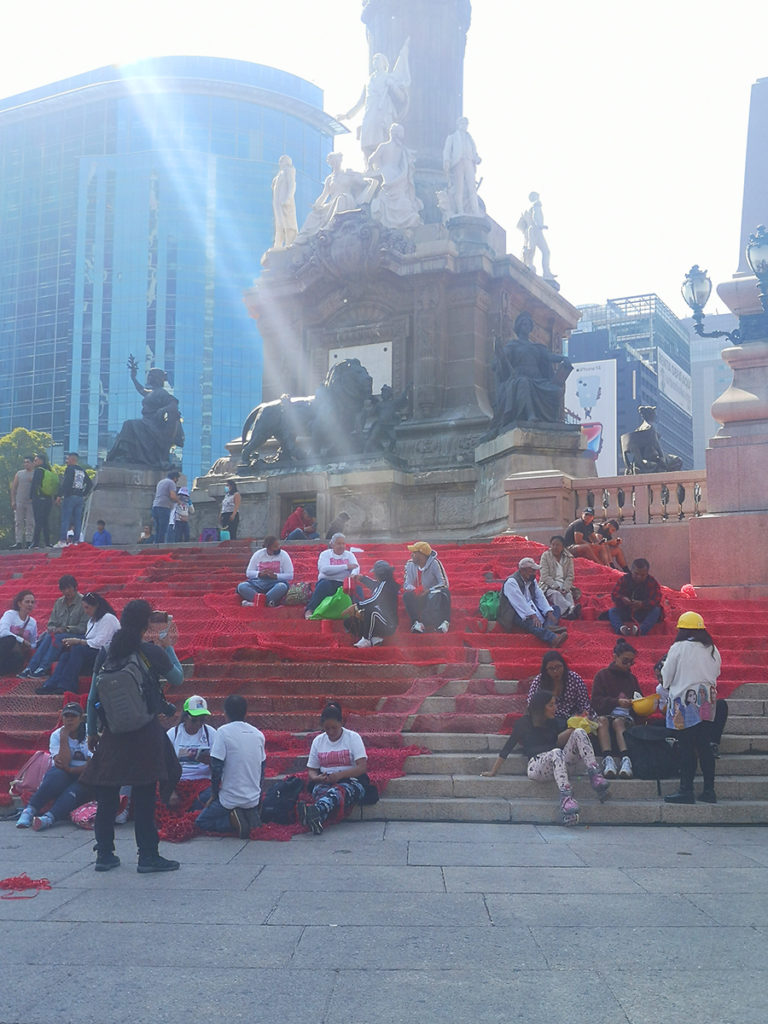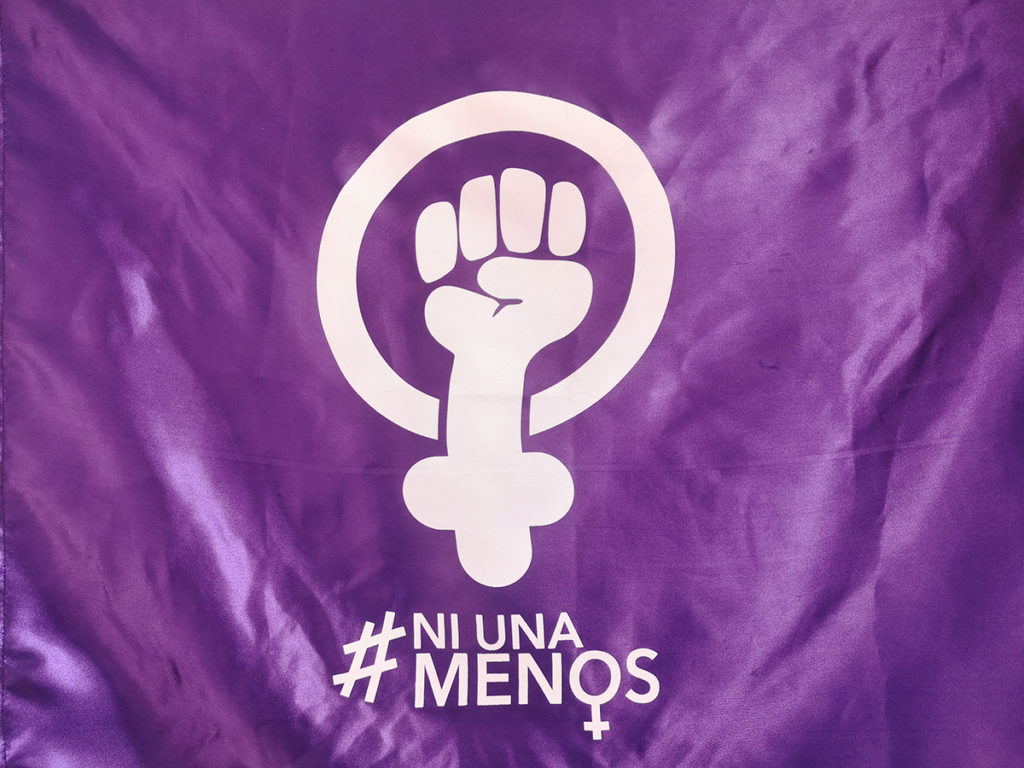
During my Cross-Canada Trauma & Triumph Tour
for Victim: A Feminist Manifesto from a Fierce Survivor last fall, I had a bit of respite in Toronto, Ontario and went to a poetry reading. It was in a back alley, in a dilapidated nook off Queen and Spadina. I didn’t know such places still exist in the rampantly gliterizing TO as shiny towers rise all around and most rough around the edges have been smoothed out. But there it was. Around the corner and down a pitted lane: bad wine and dense poetry, the kind of poetry that takes you not only to one place, but into the multiplicities of perception, breaking up the concrete surface and, in Donna Haraway’s words: “undoes thinking as usual.”[1]
Much to the thrill of my creative serendipity, one of the poets quoted David Wolpe:
The only whole heart is a broken one because it lets the light in. I had just written in my journal the night before: “In order to have real and long-lasting change, must we all know, be acquainted with trauma? Must we all have broken hearts so that light is let in?”
There are, unfortunately, countless realities as to why this is so, why we live in a world made of trauma and why if we want there to be any transformation and healing we must feel—even hurt—along with it. However, depressing as this may sound on the surface, this is not a bad thing. Heartbreak is not only logical: it’s hope.

Fairy Creek, BC, Canada,
comes to mind as the sacred stands of old growth keep coming down along with all of the species who lived there, some undiscovered before their extinction. As I write, The Dzunuk’wa Society—Wild Women of the Woods, the Guardians of the Forest[2] founded by three women of Indigenous roots (along with Pacheedaht Elder Bill Jones, friends and allies) are currently at COP15 in Montreal Canada with a cross-cut of a 750-year-old cedar that they salvaged from a clear cut showing the world what the ancestral First Nations[3] and the forest defenders have been fighting and sacrificing to save since August 2020. Not only did they bring the 9’ 6” piece of evidence from Vancouver Island, BC to Montreal, the indigenous activists also brought their ceremonial drums with the plan to play them in front of the slice of what was once an ancient tree, what they affectionately call “The Cookie.”
However, security at COP15 forbade them to play their drums and have the ceremony they had travelled thousands of miles to share. As Aunty Rainbow-Eyez—one of the founders of Wild Women—said on an Instagram Livestream on December 12th in a shaking yet strong voice: “They’re keeping us in pieces so we can’t all come together. People can carry on with their day because it doesn’t affect them personally. We have to help each other be whole. Because the people’s voice is so strong, there’s nothing stronger than the people’s voice and a ceremonial drum that comes straight from spirit.” She then added, metaphorically and literally, that the drums are a weapon. And yes, they are a weapon of peaceful resistance as the spiritual sway of ceremonial drumming has the capacity to affect emotions, move us beyond our individual cloistering, and undermine the intrenchment of the colonial system that, in Rainbow Eyez’s words, is trying to keep is a part. I particularly like the way she chose the word ‘trying,’ the progressive form of the verb dislodging the fixity of the past tense. It is through the wisdom that comes with deep feeling, and the reality of broken hearts, that we will be able to come together and be whole.

In Mexico, one comes across in-your-face-trauma every day.
This is not to say that systemic trauma is not readily available to acknowledge in countries like Canada and the US. After all, the third world exists in the first. In Vancouver BC, Canada, there is the Downtown Eastside, for example, with sexual violence, mental illness, drug addiction, stigmatization, ostratziation from familial support creating what in many ways is a kind of fourth world.[4] And, as the hierarchy of skin colour and race buttresses white-supremacy, the majority of the prostituted women and girls on the streets of the DTES are Indigenous, a continuation of the colonial fetish of the exploitation, abuse and dehumanization of the colonized.[5]
As I wrote in my last post, femicide is an epidemic in Mexico. But what I didn’t tell you in that particular piece of writing is that the 10-16 murders a day of Mexican women are directly related to the immasculinisation of Mexican men. Machismo, as an exacerbation of violent male supremacy, is a response to male disempowerment.[6] In Mexico, immasculinisation is guaranteed because of the economic exploitation of third world labour by the first and the entrapment of young men by lack of opportunity.[7] Because there are so few options, young, disempowered men are wooed by the possibility of power and prestige offered by the drug cartels. The assassinations of young men are through the violence of the cartels, which is directly connected to the fierce competition to get the narcotics to the drug-addicted markets to the north. This, in turn, is fed by the epidemic of drug addiction in Canada and the US which is a result of dysfunctional families, the colonization of Indigenous people in first world nation states and, most often, the childhood sexual abuse that results in mental illness and PTSD and the self-medication with the drugs that are tainted by the blood of young Mexican men.[8] And round and round we don’t have to continue to go.
If you’ve read this far, bear with me: even though the source of the heartbreak is often horrifying, the heartbreak in itself is liberation. As filmmaker Jennifer Abbott told me when I asked her why she commits her life to fighting for social and environmental justice: “I do what I do because I want my life to have integrity and to be meaningful.”[9]

We cannot forget about the men.
Last Sunday, riding my bike down Reforma in Mexico City, it was impossible not to stop if you have a feeling heart; the stairs of the famous Glorieta del Ángel de la Independencia were draped, shrouded, with red nets. Around the edges of the round-about, as an in-your-face-feel-this-Christmas-wreath, were photographs of young men, face after face after face after face of young missing and mostly-likely murdered young men. Large-scale vinyl posters call out desaparecido (missing) lo has visto (have you seen him) as they are carried around the country by the mothers, sisters, cousins, nieces, and friends who never give up looking for their lost loved ones, even when the looking becomes more of a quest for awareness-raising than a hope of ever finding their individual loved one again—an accusation as activism motivated by heart break.[10]
I didn’t know what to say to the women who sat on the steps weaving the nets. What do you say to people who sit surrounded by the faces of their disappeared sons, brothers, nephews, cousins, friends and their undying pleas for help? I wanted to thank them, though, congratulate them on the potency of this installation, how the young men are trapped in the inevitability of their own blood-shed. Sangre de mi Sangre, blood of my blood, the blood of all our blood. The name of their organization is Collectivo Hilos (The Collective of Thread). Lo siento mucho (I’m so sorry), I fumbled and told them I would share their story with the world beyond Mexico.

Why are all of these young men missing? Why do so many men in Mexico assault and murder their girl-friends and spouses? Why is there often no other opportunities but for the young Mexican men to be recruited by drug cartels as foot soldiers and end up disappeared and dead? Why are there so many drug-addicted, mentally ill, sexually abused people on the streets in Canada and the US? Why are what remains of old growth rainforests around the world being destroyed and, with it, the future of the planet and all that lives here, not just us? As the Mexican women weave their red nets, we are all caught in the collective thread. These are not separate incidents, cut up by borders, race, class, obliviousness and sheer good luck. And knowing this, and feeling this, is a gift. If all trauma were collective, if we become whole through the wisdom of awareness, if we embrace the necessity of our broken hearts, dark will become light.
Happy Solstice!
Merry Christmas!
The Logical Feminist (aka Karen Moe)

#iloveendnotes #contextisrevolution
[1] Donna Haraway quotes from https://www.e-flux.com/journal/75/67125/tentacular-thinking-anthropocene-capitalocene-chthulucene/; https://www.dukeupress.edu/staying-with-the-trouble
[2] From the Dzunuk’wa Society, Wild Women of the Woods Instagram: Stand with us to protect our irreplaceable rainforests for generations to come…
Ending the logging of all Old Growth forests for the next 7 generations & beyond.
The Dzunuk’wa Society, founded by three women with Indigenous roots (along with Elder Bill Jones, friends and allies), began work to protect the ancient temperate rainforests — the irreplaceable Old Growth of British Columbia…and we won’t stop until they are protected.
The current system favours short term industry profit over people. The current system dishonours the intention of the UN Declaration of the Rights of Indigenous People (UNDRIP), fails to protect indigenous sovereignty and natural law and is destroying our natural systems – our lands, forests, waters, air, and the future of the children.
They are raising money to continue to guard and help save what is left of the last stands of temperate rainforest in the world. Click here to donate
[3] As opposed to the Band Council who are the colonial government representatives on the reservations that were both set up by the Indian Act in 1876 and has insidiously oppressed the first peoples ever since.
[4] See Gabor Maté The Realm of the Hungry Ghosts: Close Encounters with Addiction
[5] “Prostitution exploits and reinforces racist representations and inequalities by transforming women’s bodies into objects of market and desire: it is the fruit of colonial sexual imaginaries which have shaped the mentalities of colonising societies and conditioned those of the dominated. In this sense, the purchase of a sexual act is rooted in these colonialist and imperialist dynamics and it is a fundamentally racist act.” Last Girl First: Prostitution at the intersection of sex, race and class-based oppressions. CAP International, 2022: 106
[6] See Sayak Valencia’s Gore Capitalism for an in depth analysis of the third world, emasculated man. What she calls, the ‘endriago subject.’
[7] In 2021, I visited the NGO Nacidos Para Triunfar in Monterrey and wrote an article about young men in Mexican barrios being recruited by the drug cartels to be foot soldiers (and many end up murdered) and how Nacidos Para Triunfar works in the barrios to make peace treaties between the clikas (small street level cartels) and offer the predominantly young men education and employment.
[8] Mexico has an overt hierarchy of skin colour. Significantly, of all of the photos I saw of disappeared and assassinated young men on Sunday, none of the had white skin, re: all of the victims were Indigenous, or at least mostly because the Spanish Conquistadores mixed with the Indigenous in comparison to in Canada where the European coliners and the Indigenous colonizers were mainly segregated in the reservation system.
[9] https://en.wikipedia.org/wiki/Jennifer_Abbott
Hear Jennifer speak about her life and work here on a YouTube documentary:
“Empowering the Invisible.”
[10] See The Raw Truth: Francisco Toledo’s Duelo and the Disappeared of Ayotzinapa for an interview with the late artist, Francisco Toledo, where he talks about his series of ceramic sculptures, Duelo, being “an accusation, a statement to the government, declaring it internationally, telling the whole world about this injustice.” https://www.vigilancemagazine.com/post/the-raw-truth-francisco-toledo-s-duelo-and-the-43-disappeared-of-ayotzinapa
I am:
an art critic, visual and performance artist, author and feminist activist. My work focuses on systemic violence in patriarchy: be it gender, race, the environment or speciesism. My art criticism has been published internationally in magazines, anthologies and artist catalogues in English and Spanish and I have exhibited and performed across Canada, in the US and in Mexico. I am the recipient of the “Ellie Liston Hero of the Year Award” 2022 for being instrumental in the life sentence given to a serial rapist who abducted and brutalized me and countless other women. Since that time, as I write in my book, Victim: A Feminist Manifesto from a Fierce Survivor:
“And, believe it or not, what I suffered and survived …. all of those years ago gave me a gift of knowing my strength and what I can survive. And now, resistance, fighting for justice for all, is what I live for. My life is far bigger than myself.”(186)
My personal experience of surviving and triumphing over sexual violence and trauma is the origin of Logical Feminism.
I live in Mexico City and British Columbia, Canada. Victim: A Feminist Manifesto from a Fierce Survivor is my debut book.

Thank you for an inspiring feminist perspective on the systemic oppression of the patriarchy on such a spectrum of the marginalized in North America. The cyclical nature of this oppression is depressing. Your dedication to bring a voice to the marginalized encourages optimism.
Hi Skye! Thanks so much for your beautiful comment 🙂 It thrills me to hear that my life’s work of bringing voice to the marginalized encourages optimism! And of course the marginalized extending beyond the human. What is needed is an ideological revolution with the fundamental goal of breaking the bonds of individualism in Western culture, which unfortunately affects everyone and everything. It is possible because Western culture has not always been this way and many other cultures never have been. Where it is possible, there is optimism.